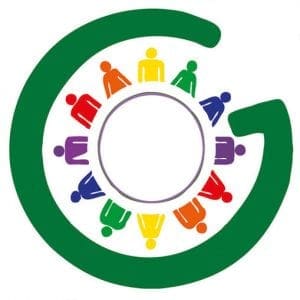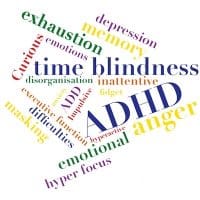 If you have a friend or loved one with ADHD and would like to understand them better, one of the first things to remember is that their brains don’t work in the same way as a neurotypical person’s. Therefore, expecting someone with ADHD to behave like someone without it is like asking a right-handed person to write with their left hand. Although they can practice and improve at this task, it does not come naturally.
If you have a friend or loved one with ADHD and would like to understand them better, one of the first things to remember is that their brains don’t work in the same way as a neurotypical person’s. Therefore, expecting someone with ADHD to behave like someone without it is like asking a right-handed person to write with their left hand. Although they can practice and improve at this task, it does not come naturally.
What is the ADHD Iceberg?
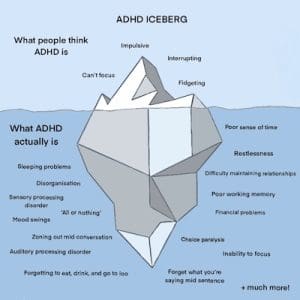 The ADHD iceberg, popularised by Dr Russel Barkley, is a great visual metaphor to help us understand there is much more to ADHD than the outwardly visible behaviour. ADHD is a complex condition with a broad range of symptoms, many of which are hidden below the surface and therefore harder to detect.
The ADHD iceberg, popularised by Dr Russel Barkley, is a great visual metaphor to help us understand there is much more to ADHD than the outwardly visible behaviour. ADHD is a complex condition with a broad range of symptoms, many of which are hidden below the surface and therefore harder to detect.
It’s also important to note that not everyone experiences the same range or level of symptoms. They can present differently depending on age, environment, and coping mechanisms, amongst other things.
With this in mind, below we have outlined 5 of the more common symptoms of ADHD, using visual representations to better explain them;
1 ADHD paralysis
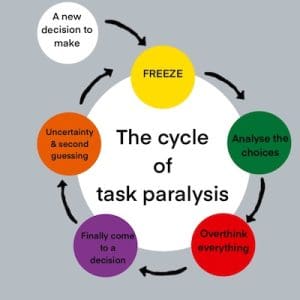
ADHD paralysis, also referred to as task paralysis, is a symptom which makes initiating or completing tasks really hard due to overwhelming options or stimuli. This manifests as an inability to focus, prioritise, or make decisions, leading to a cycle of feeling stuck or immobilised.
The less the person can move forward, the more stressful things become, because the pressure to complete the task compounds. It can affect various aspects of daily life of someone with ADHD, from work and education to personal relationships, causing frustration and anxiety.
But there are ways to help manage the paralysis, such as ;
- Setting clear goals.
- Breaking tasks in to smaller, more manageable steps.
- Seeking support from therapists or ADHD coaches to develop coping mechanisms.
2 Mental and physical exhaustion
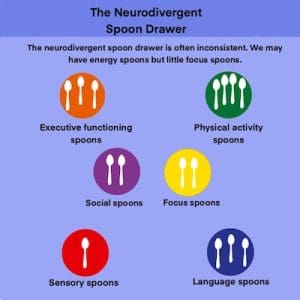 The energy required on a daily basis for someone with ADHD can lead to feeling both mentally and physically exhausted. This is exacerbated because neurodiverse people not only have limited energy resources but they expend more on everyday tasks.
The energy required on a daily basis for someone with ADHD can lead to feeling both mentally and physically exhausted. This is exacerbated because neurodiverse people not only have limited energy resources but they expend more on everyday tasks.
A powerful analogy that explains this better is the ‘spoon theory’. The ‘spoons’ are used to represent units of energy needed to complete tasks throughout the day and track how much energy remains.
Fit and healthy neurotypical individuals have an unlimited supply of spoons, whereas someone with ADHD has a finite number. This forces them to budget and prioritise what they are used for. Tasks that seem simple to others, such as getting out of bed or preparing a meal, can take up a lot of emotional and physical energy, leaving less for other activities.
3 Inattention
 Because the focus is constantly shifting for someone with ADHD, they can struggle to maintain attention on tasks, conversations, or instructions. This can lead to incomplete work or missed details and deadlines. The ‘Torch analogy’ demonstrates how this lack of attention manifests.
Because the focus is constantly shifting for someone with ADHD, they can struggle to maintain attention on tasks, conversations, or instructions. This can lead to incomplete work or missed details and deadlines. The ‘Torch analogy’ demonstrates how this lack of attention manifests.
Imagine the torchlight represents someone’s attention. With most torches, you can adjust this beam of light narrow or wide to focus better on the subject. But for someone with ADHD, that torch beam is always set at its fullest width, illuminating everything in front of them, even if they only want to focus on the path directly ahead. This can cause confusion, highlighting many unnecessary things and not providing the tight focus that some tasks demand.
4 Forgetfulness and disorganisation
 Forgetfulness is also common, and the challenges that this brings can affect academic or work performance, disrupt relationships, and make the person experiencing it feel frustrated and self-deprecating.
Forgetfulness is also common, and the challenges that this brings can affect academic or work performance, disrupt relationships, and make the person experiencing it feel frustrated and self-deprecating.
A great analogy to explain this is imagining that the working memory with ADHD is like a sticky note board, and all the life tasks are sticky notes. But this board has limited space which means that as the notes are added, they start to overlap each other, covering up some tasks and confusing the priority of others. This causes difficulty when it comes to recalling and retaining the information required to complete these tasks. So, details are missed, some tasks are forgotten entirely, and priority order goes out of the window.
This state of forgetfulness and disorganisation is exacerbated by the stress and anxiety it causes.
5 Emotional dysregulation
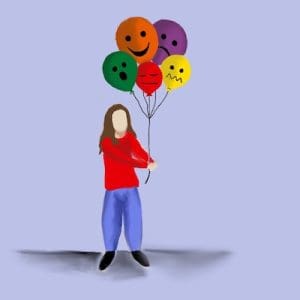 Emotional dysregulation can be one of the most challenging ADHD symptoms to manage because it impacts both the person with ADHD and those around them. The person experiencing it has difficulty controlling their emotions.
Emotional dysregulation can be one of the most challenging ADHD symptoms to manage because it impacts both the person with ADHD and those around them. The person experiencing it has difficulty controlling their emotions.
This can manifest as;
- Impulsivity
- Emotional sensitivity
- Self-destructive behaviour
- Intense mood swings
When someone is struggling with these things interactions don’t always go to plan, and there is a greater risk of misinterpreting scenarios and comments. If you have found this useful and would like to find out more about ADHD, then take a look at ADHD UK, which offers some great resources and advice.
